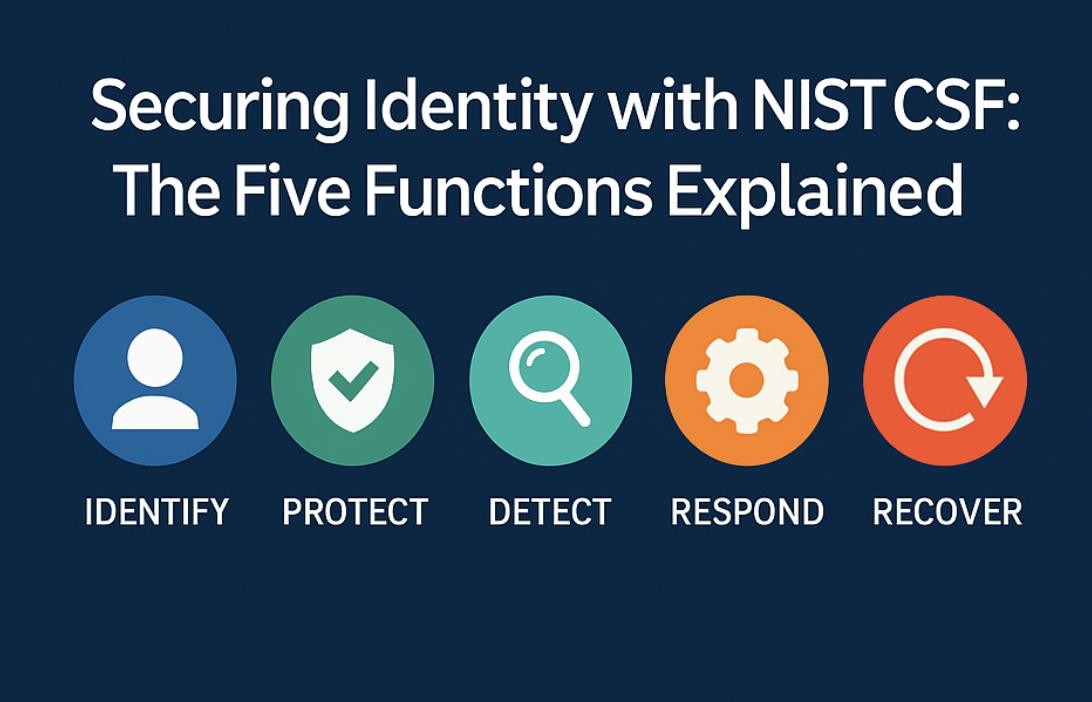
TL;DR
If you’re leading or supporting an Identity and Access Management (IAM) program, you’re already touching all five functions of the NIST Cybersecurity Framework (CSF)—you just may not be thinking of it that way. This post breaks down how each function of the NIST CSF maps directly to your identity lifecycle, from provisioning to detection to post-breach recovery.
🧠 Background: Why NIST CSF Still Matters
The NIST Cybersecurity Framework (CSF) remains a go-to model for organizations aiming to assess and improve their security posture. It’s vendor-agnostic, risk-based, and widely recognized across industries. But too often, IAM professionals overlook how seamlessly it aligns with the core disciplines of identity security.
If you’re responsible for Okta, Azure AD, provisioning workflows, privileged access, or security governance—this framework is already embedded in what you do. Let’s break it down.
🔍 Identify – Know Your Identities and Risks
Before you protect anything, you must understand who and what you’re defending.
IAM Actions:
- Create and maintain an authoritative source of truth (e.g., Workday, Active Directory).
- Inventory all user types (employees, vendors, bots, service accounts).
- Conduct identity classification (critical, elevated, standard access).
Tools You Might Use:
- Okta + HR-as-a-Master
- SailPoint or Saviynt for identity cataloging
- PowerShell scripts for account discovery across AD and LDAP
🛡 Protect – Implement Strong Identity Controls
Protecting access is the cornerstone of IAM—and aligns with some of your biggest wins.
IAM Actions:
- Enforce RBAC or ABAC for access management.
- Mandate phishing-resistant MFA across all accounts.
- Scope admin roles with least privilege principles.
- Use SCIM, Okta Workflows, or Terraform to manage entitlements as code.
Tools You Might Use:
- Okta with FIDO2/WebAuthn
- Azure Conditional Access
- HashiCorp Vault for secret rotation
👁 Detect – Monitor Identity Signals
Detection isn’t just about network anomalies—it’s about monitoring identity behavior.
IAM Actions:
- Aggregate logs across SSO, AD, PAM, and IAM solutions.
- Enable alerts for suspicious activities (e.g., impossible travel, MFA fatigue).
- Regularly review admin activity and access grants.
Tools You Might Use:
- Splunk, Sentinel, or Panther for log correlation
- Identity Threat Detection & Response (ITDR) tools
- Okta System Log + API-based SIEM feeds
⚙ Respond – Act Quickly on Identity Incidents
When credentials are compromised, time is critical.
IAM Actions:
- Automate account lockout and token revocation workflows.
- Integrate SOAR playbooks that include IAM controls.
- Remove privileged roles from breached identities in real-time.
Tools You Might Use:
- Okta Workflows or PowerShell for dynamic revocation
- Sentinel with JIT response rules
- CyberArk or BeyondTrust with automatic session terminations
🔁 Recover – Regain Trust and Validate Controls
The often-overlooked phase: recovery. But it’s where your IAM program builds long-term resilience.
IAM Actions:
- Reprovision access based on new validation.
- Rotate all affected secrets, passwords, and API tokens.
- Conduct post-mortem access reviews and improve onboarding/offboarding workflows.
Tools You Might Use:
- SCIM re-sync or manual JIT provisioning
- ITSM (ServiceNow/Jira) workflows for re-certification
- Credential rotation policies via 1Password or Vault
✅ Final Thoughts
NIST CSF isn’t just for the GRC team—it’s a battle-tested map for building a defensible IAM strategy.
When IAM leaders align their workflows to the CSF functions, you:
- Improve audit readiness
- Strengthen Zero Trust posture
- Align identity governance with enterprise risk goals
📩 Want to operationalize NIST CSF in your IAM stack?
Let’s talk:
jay@everydayidentity.tech
🔗
everydayidentity.tech
Everyday Identity – Breaking down Identity, one post at a time.